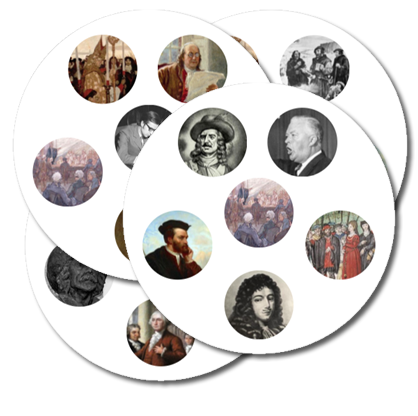Chronos: A Timelining Game for Elementary History,
Originally released by consultant Daniel Deschenes of the Commission scolaire des Découvreurs, the Chronos games asks students to timeline key events in the Elementary program. Daniel’s original package includes a presentation, a workshop with instructions, and playing cards presented as printable PDFs (matrices) you can print then laminate: (Pour télécharger le jeu original, visitez le CS des Découvreurs ici).
And now: An English, adapted and expanded version:

“Work (and play!) with chronology in the social sciences. Chronos, is a board game inspired by Timeline, that features the 35+ events from the primary history program. Chronos stimulates motivation in your students and promotes collaborative work. Throughout the game, students must build timelines in a competitive context. At the same time, they have to validate hypotheses in order to situate the events in relation to each other. Variations of the game are also proposed. The target audience for the game is the 3rd cycle of primary school.”
About the card design: Using live Google Drawings, the expanded English version includes the card’s picture front, and the usual dated back. These are the two card faces used in the game. However, we added an extra information back side, which in the future could allow for more complex games and Intellectual Operations to be performed. The new “second back” has space for a summary text, along with QR codes that link to the expanded original text sources (often a Societies and Territories page), and in some cases a QR code leading to videos, 3D or 360-degree virtual reality tours, mapping locations, etc!
The Chronos English GHCE Edition contains:
— Instructions for various games
The Chronos Timeline game instructions are now updated and can be viewed here.
The older version, including the “Who is the Intruder” game strategy option is still available is here.
![]() — Print-quality versions of the Chronos cards
— Print-quality versions of the Chronos cards
We have found an easier way… for us to organize the original cards and for you to print them!
We have now recreated all our cards in a Google Slides document at the following address. These can be then downloaded as a PDF all at once, and from our tests, the quality seems high enough for printing purposes. You will need to print two cards to a page using layout options and maybe adjust scale to get cards you like. (Test with one pair of cards first!).
Chronos Cards as Google Slides are here!
— Original Google Drawings working folder 
Note also, that our actual Google drawings working folder is still available here, if ever you want to try looking inside, copying one and making your own cards from those models! They should be the same as the above Slides. Note that you can also “Download” the whole folder to get individual jpegs of a lesser quality for other uses.
And remember, of course, that designing games and creating cards using these and other Societies and Territories resources and tools could be a great learning activity for students too!
— New addition using same cards: Spot it!
 More of a proof of concept at this point, but if you know how to play Spot it! this new card set could be great fun! We used a select 31 of the Chronos cards to develop our own Chronos Spot it game cards! We trimmed certain of the original cards, and even created a few new ones, so as to be able to show identifiable faces. Then we used Aaron Barker’s Spot It clone generator page here, and voilà!
More of a proof of concept at this point, but if you know how to play Spot it! this new card set could be great fun! We used a select 31 of the Chronos cards to develop our own Chronos Spot it game cards! We trimmed certain of the original cards, and even created a few new ones, so as to be able to show identifiable faces. Then we used Aaron Barker’s Spot It clone generator page here, and voilà!
How might you use these in class? Well, anything goes really, the cards are here to use as you like. However, we were thinking of something like this: First team to see what matches in the two drawn cards gets a point, then if they can identify who/what the image represents, another point. Then maybe they get another chance to perform a higher-level task referring to the original Chronos card or information back (ex. connect facts, place in time, etc.). For the next card pair to be drawn, the team who got the last one gets to turn the next pair over, giving them a slight advantage. The team with the most cards or points at the end wins. Click to access the PDFs of currently available Spot It cards.
